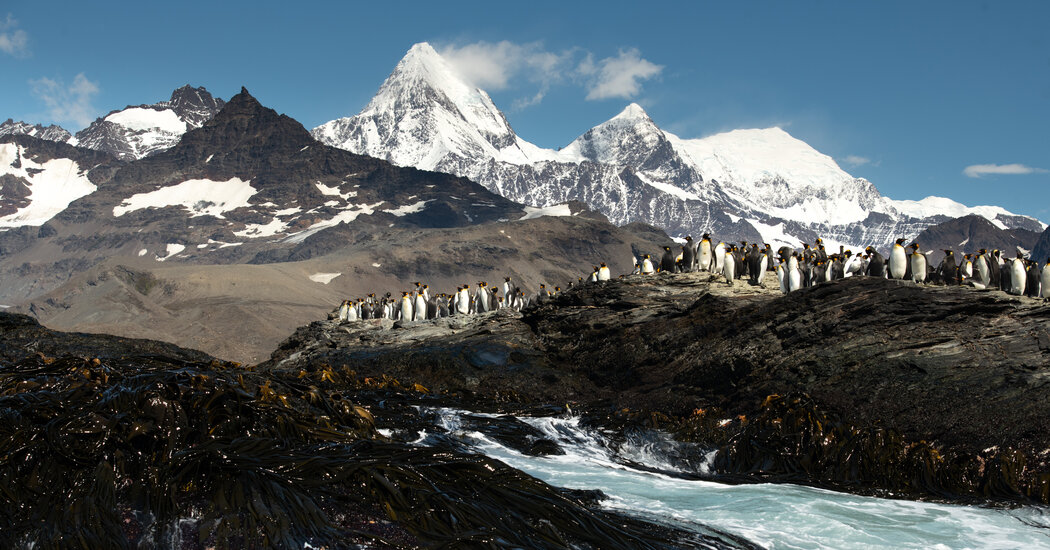
Sally Poncet first came to South Georgia in 1977. Back then, she said, the sub-Antarctic island was as gorgeous as it is today: A spine of mountains, some 100 miles long, defines the terrain; glaciers drape down from the peaks, with verdant slopes running up to meet them; glistening beaches wrap around the shoreline. But in those days, Ms. Poncet recalled, the island had an empty feel to it. “You felt a lack,” she explained. “It wasn’t alive like you knew it could be.”
Nobody knows South Georgia the way Ms. Poncet does. An independent field ecologist, she has surveyed or counted everything from its grasses and albatrosses to its elephant seals. Her second son was born on a sailboat here in 1979. Now, at the age of 69, she continues to work in the field — just as she did 45 years ago.
South Georgia is part of a remote British Overseas Territory with no permanent population. It sits on the edge of the Southern Ocean over 900 miles northeast of the tip of the Antarctic Peninsula and almost 900 miles east of the Falkland Islands.
Its history reads like a list of offenses against nature, including commercial sealing, commercial whaling and the introduction of nonnative species, including rats and reindeer.
Now that hunting is history and the invasive mammals have been eradicated, Ms. Poncet and her colleagues are witnessing a remarkable ecological recovery. The scientific literature delivers a muted version of it, but in listening to the scientists — who are driven by data and not prone to hyperbole — their joy and wonder comes tumbling out. Among the terms they used to describe the island’s revival: “miraculous,” “spectacular,” “really emotional,” and “a beacon of hope.”
Of course, in the era of climate change, nothing is that simple. But the rebirth of this island is readily observable. All you have to do is listen.
The first person known to explore the island — and to plant a flag — was Captain James Cook, in 1775. He called it “savage and horrible,” but he also found millions of Antarctic fur seals lining the beaches, which prompted a rush to harvest their pelts. The sealers arrived in 1786; over the next century, millions of animals were killed, their fur turned into luxury items such as top hats. As a result, the fur seal was almost wiped out.
At the same time, hunters killed southern elephant seals, including the enormous bulls that can reach 8,000 pounds. Their blubber was converted into oil, and the hunting continued into the 1960s. As both of these species disappeared, so, too, did their barks and roars — and the beaches grew quieter and quieter.
Whaling at South Georgia began with Carl Anton Larsen, a Norwegian captain and businessman who established a settlement called Grytviken in 1904. Mr. Larsen and his crew killed their first whale on Christmas Eve, and by the end of that season they had caught 183 whales, primarily humpbacks, without ever leaving the bay.
Over the next 60 years, a handful of shore-based stations processed 175,250 whales, a figure that doesn’t include the pelagic factory ships — large oceangoing vessels that could process whole carcasses entirely on board — that operated with impunity throughout the Southern Ocean. This massive harvest left blue whales, the largest animal ever known to exist, critically endangered.
When whaling on South Georgia ended for good in 1965, it, too, left behind a largely silent ocean.
Major human impacts continued on land. Mr. Larsen brought reindeer to South Georgia so that the whalers had something to hunt. While glaciers, which act as natural partitions, confined the animals to two of South Georgia’s peninsulas, their populations still grew steadily, especially after the stations closed. In many places, the reindeer trampled the fragile landscape.
Rats and mice also accompanied the sealers and whalers. Rats in particular found plenty of bird eggs and chicks to feed on, including those of two endemic species: the South Georgia pintail, a small duck; and the South Georgia pipit, the island’s only songbird. These birds were literally swallowed up — and their songs vanished, too.
Progressing from such conditions to, as Ms. Poncet said, “an island that is settling back into its own natural rhythm” is in some ways very simple: Leave it alone.
Sealing and whaling ended largely for commercial reasons; later, the practices were banned. The only all-island fur seal census took place in 1991, about 200 years after the peak of the fur sealing era, and the estimate was 1.5 million animals. Today, that number is likely between three and six million and still rising. Southern elephant seals, last surveyed in the ’90s, are estimated to be stable at 400,000 animals. These populations are coming back on their own; our role is to stand back and let it happen, which includes protecting their food sources such as krill and squid.
One result of these changes is a soundscape replete with squeaking, barking, belching, groaning and growling.
“Seals are calling everywhere,” said Ms. Poncet., “It’s constant — absolutely constant noise.”
Counting whales and understanding their habits can be an arduous task, but Jen Jackson, a whale biologist with the British Antarctic Survey, is working on it. Dr. Jackson’s research methods include professional observers, biopsy darts, fecal samples, droplets of whale breath, acoustic detectors and satellite tags. Using historical catch counts and new scientific data, her team has concluded that humpbacks are back to their pre-whaling numbers; there are 24,500 of them in the Scotia Sea, which surrounds South Georgia.
Blue whale recovery has been much slower, and their population estimate, not yet released, will be based on photo identification. But one of the best signs, Dr. Jackson said, comes from the sounds she hears underwater. “What you’ve got in the underwater environment now is blue whales calling nearly continuously,” she said, noting that the whales were nearly wiped out entirely.
“It just makes my heart sing,” she added. “We are watching the ocean rewild itself.”
Ridding the island of the invasive land mammals — reindeer, rats and mice — required a monumental effort and over $13 million, but the payoff for wildlife has been extraordinary. During the summer of 2013, teams that included both Indigenous Sámi reindeer herders and Norwegian marksmen came to eradicate a reindeer population of 6,700 animals. The marksmen returned in 2014; they were so efficient that for every 10 animals they killed, they used just 11 bullets. By 2015, the island was free of reindeer.
Travel Trends That Will Define 2022
Looking ahead. As governments across the world loosen coronavirus restrictions, the travel industry hopes this will be the year that travel comes roaring back. Here is what to expect:
Meanwhile, another effort was underway: the largest rat eradication project in history. Relying on ship support, helicopters and the expertise of 39 team members (ranging from logisticians to camp cooks), these specialists sprinkled 333 tons of specially formulated poison pellets across every square inch of rat habitat, and then waited. In the austral summer, they monitored for rat presence, using (among other things) sticks painted with peanut butter. The island was declared rat-free in 2018 — and the mice were gone, too.
The pipits poured in from rat-free areas so fast that scientists didn’t have time to document their recovery. Because these birds can lay four clutches of between three and five eggs per year, their numbers grew in a flash. Meanwhile, those living at the main British Antarctic Survey station found themselves watching large rafts of pintail ducks in the harbor during wintertime, and flushing pipits and pintails from the tussac grass during spring.
“It was like Grytviken was haunted by pintails,” said Jamie Coleman, a biologist who has spent three years on South Georgia. “You could constantly hear their whistling throughout the buildings.”
Not every species has experienced the same rebound. Macaroni penguin populations are plummeting, even as king penguin numbers rise — in part because glacial retreat reveals more breeding habitat for king penguins to exploit.
Sei whales are still less common than they used to be, and the light-mantled albatross, a gorgeous pewter bird whose call Ms. Poncet refers to as the “soul of South Georgia,” is quickly disappearing.
The impacts on these species, including climate change and associated changes in the ocean, are much more difficult to contend with.
Back on the island, Ms. Poncet said she sometimes steps outside during the night to listen to the seabirds. This season she could hear white-chinned petrels and prions. “Their calls are coming back now through the night where it was silent before,” she said, adding that the birds’ revival is just the beginning of the island’s ecological changes. “Every year I get back I just think, wow, how lucky can I be to see it change year on year.”
“We are able to do good things — we are,” she added. “And South Georgia is one of those examples.”




